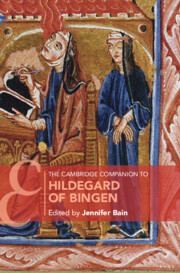42 results
Polymerization of Benzene and Aniline on Cu(II)-Exchanged Hectorite Clay Films: A Scanning Force Microscope Study
-
- Journal:
- Clays and Clay Minerals / Volume 44 / Issue 6 / December 1996
- Published online by Cambridge University Press:
- 28 February 2024, pp. 769-773
-
- Article
- Export citation
Appendix 13.2 - Reproductions of W, Folio 181r, and V, Folio 158v, with Latin texts transcribed and an English translation provided
- from Chapter 13 - Hildegard of Bingen and Her Scribes
-
- Book:
- The Cambridge Companion to Hildegard of Bingen
- Published online:
- 28 October 2021
- Print publication:
- 04 November 2021, pp 301-305
-
- Chapter
- Export citation
Tables
-
- Book:
- The Cambridge Companion to Hildegard of Bingen
- Published online:
- 28 October 2021
- Print publication:
- 04 November 2021, pp xi-xi
-
- Chapter
- Export citation
Select Bibliography
-
- Book:
- The Cambridge Companion to Hildegard of Bingen
- Published online:
- 28 October 2021
- Print publication:
- 04 November 2021, pp 306-312
-
- Chapter
- Export citation
Part II - Writings and Reputation
-
- Book:
- The Cambridge Companion to Hildegard of Bingen
- Published online:
- 28 October 2021
- Print publication:
- 04 November 2021, pp 83-206
-
- Chapter
- Export citation
Part III - Music, Manuscripts, Illuminations, and Scribes
-
- Book:
- The Cambridge Companion to Hildegard of Bingen
- Published online:
- 28 October 2021
- Print publication:
- 04 November 2021, pp 207-305
-
- Chapter
- Export citation
Music Examples
-
- Book:
- The Cambridge Companion to Hildegard of Bingen
- Published online:
- 28 October 2021
- Print publication:
- 04 November 2021, pp xii-xii
-
- Chapter
- Export citation
Index
-
- Book:
- The Cambridge Companion to Hildegard of Bingen
- Published online:
- 28 October 2021
- Print publication:
- 04 November 2021, pp 313-325
-
- Chapter
- Export citation
Appendix 13.1 - Copies of the Trilogy Made on the Rupertsberg
- from Chapter 13 - Hildegard of Bingen and Her Scribes
-
- Book:
- The Cambridge Companion to Hildegard of Bingen
- Published online:
- 28 October 2021
- Print publication:
- 04 November 2021, pp 300-300
-
- Chapter
- Export citation
Dedication
-
- Book:
- The Cambridge Companion to Hildegard of Bingen
- Published online:
- 28 October 2021
- Print publication:
- 04 November 2021, pp v-vi
-
- Chapter
- Export citation
Copyright page
-
- Book:
- The Cambridge Companion to Hildegard of Bingen
- Published online:
- 28 October 2021
- Print publication:
- 04 November 2021, pp iv-iv
-
- Chapter
- Export citation
Chapter 10 - Music, Liturgy, and Intertextuality in Hildegard of Bingen’s Chant Repertory
- from Part III - Music, Manuscripts, Illuminations, and Scribes
-
-
- Book:
- The Cambridge Companion to Hildegard of Bingen
- Published online:
- 28 October 2021
- Print publication:
- 04 November 2021, pp 209-234
-
- Chapter
- Export citation
Acknowledgments
-
- Book:
- The Cambridge Companion to Hildegard of Bingen
- Published online:
- 28 October 2021
- Print publication:
- 04 November 2021, pp xvi-xvi
-
- Chapter
- Export citation
Contents
-
- Book:
- The Cambridge Companion to Hildegard of Bingen
- Published online:
- 28 October 2021
- Print publication:
- 04 November 2021, pp vii-viii
-
- Chapter
- Export citation
Introduction
-
-
- Book:
- The Cambridge Companion to Hildegard of Bingen
- Published online:
- 28 October 2021
- Print publication:
- 04 November 2021, pp 1-8
-
- Chapter
- Export citation
Part I - Life and Monastic Context
-
- Book:
- The Cambridge Companion to Hildegard of Bingen
- Published online:
- 28 October 2021
- Print publication:
- 04 November 2021, pp 9-82
-
- Chapter
- Export citation
Figures
-
- Book:
- The Cambridge Companion to Hildegard of Bingen
- Published online:
- 28 October 2021
- Print publication:
- 04 November 2021, pp ix-x
-
- Chapter
- Export citation
Contributors
-
- Book:
- The Cambridge Companion to Hildegard of Bingen
- Published online:
- 28 October 2021
- Print publication:
- 04 November 2021, pp xiii-xv
-
- Chapter
- Export citation

The Cambridge Companion to Hildegard of Bingen
-
- Published online:
- 28 October 2021
- Print publication:
- 04 November 2021
Costing resource use of the Namaste Care Intervention UK: a novel framework for costing dementia care interventions in care homes
-
- Journal:
- International Psychogeriatrics / Volume 32 / Issue 12 / December 2020
- Published online by Cambridge University Press:
- 21 February 2019, pp. 1429-1438
-
- Article
- Export citation



